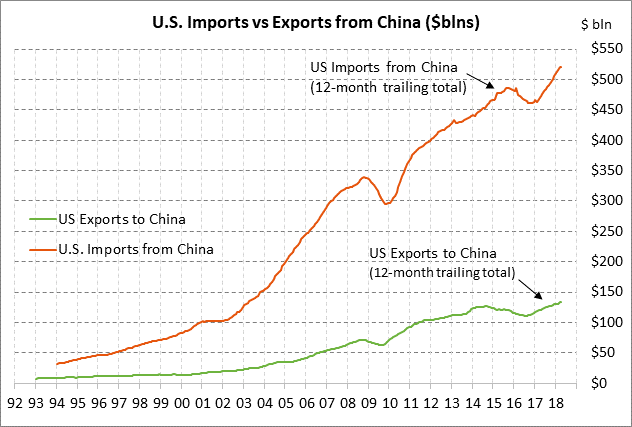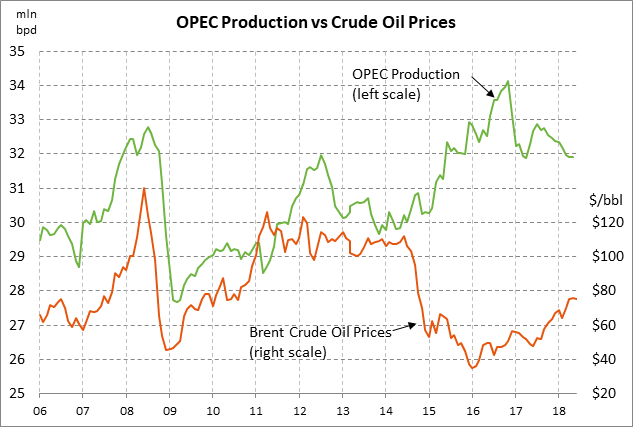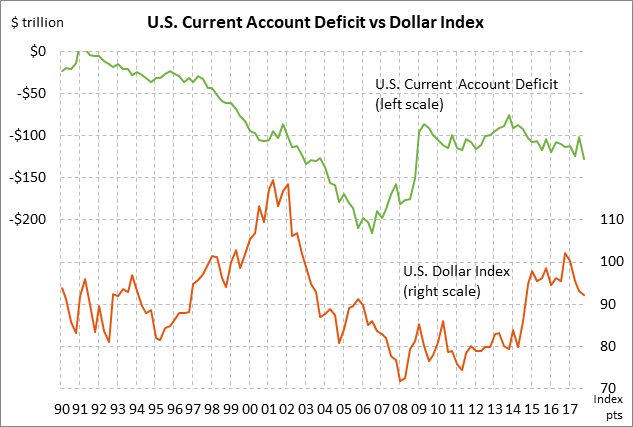- Chinese stocks plunge on new trade threat
- Oil prices lose ground on trade tensions
- U.S. existing home sales expected to remain strong
- U.S. current account deficit expected to hit new 9-year high
Chinese stocks plunge on new trade threat — The Shanghai Composite index on Tuesday plunged to a 2-year low and closed the day down -3.78%. The Shanghai index on Tuesday’s low corrected lower by a total of -19.95% from January’s 2-1/2 year high, coming very close the -20% sell-off that typically defines a bear market. At one point during Tuesday’s plunge, there were 1,023 Chinese stocks that fell by the -10% daily limit, illustrating wholesale panic and margin selling.
Chinese investors were blindsided by President Trump’s order to his trade representative on Monday night to identify another $200 billion of Chinese products that could be subject to a 10% tariff as punishment for China’s retaliation on the first $50 billion tranche. Mr. Trump said that if China retaliates on the new $200 billion tranche, then he will levy a tariff on another $200 billion of Chinese products, bringing the total to $450 billion.
The U.S. stock market also reacted negatively to the new trade threat but closed the day with a loss of only -0.40%. The losses in U.S. stocks were less severe in part because China has only about $133 billion of U.S. exports to retaliate against while the U.S. has a much richer target of $521 billion worth of Chinese imports.
However, China made clear that it has more tools than just tariffs in its retaliation toolbox when it said, “If the U.S. loses its senses and publishes such a list, China will have to take comprehensive quantitative and qualitative measures.” The “quantitative” measures likely referred to tariffs, while the “qualitative” measures likely referred to other types of retaliation such as cracking down on U.S. companies operating in China. U.S. companies operating within China have sales exceeding $500 billion per year and assets exceeding of $900 billion. Companies with particularly high exposure to Chinese sales were hit hard in the stock market yesterday due to their exposure to Chinese retaliation.
Other Chinese retaliatory measures could include devaluing the yuan to ease the tariff burden and cutting back on the purchase of Treasury securities. China owns $1.2 trillion worth of U.S. Treasury securities, accounting for 19% of total foreign ownership of Treasury securities. China would be shooting itself in the foot if it actually started selling Treasury securities since that would cause losses on the rest of its holdings. In a full-blown trade war, however, rationality has already been thrown out the window in favor of scorched earth tactics.
Oil prices lose ground on trade tensions — July WTI crude oil prices yesterday closed sharply lower by -0.78 (-1.18%) at $65.07 but managed to remain above Monday’s 2-month low. Oil prices yesterday were undercut by Monday night’s news that President Trump threatened to slap a 10% tariff on another $200 billion of Chinese goods, which would draw Chinese retaliation on U.S. energy exports.
Oil prices also remained on the defensive ahead of Friday’s OPEC meeting, which is expected to be contentious. Russia continues to push for a big 1.5 million bpd increase in production to offset the drop in Venezuelan production and the drop later this year in Iranian oil production and exports as U.S. sanctions bite. Saudi Arabia is reportedly pushing for a compromise with a smaller production hike on the order of 300,000-600,000 bpd.
However, Iran says it will not accept any production increase and said it will not attend Saturday’s OPEC+ meeting. Since OPEC agreements must be unanimous, there is a distinct possibility that OPEC at Friday’s meeting will not be able to reach a production hike agreement. Even if there isn’t an agreement, however, Saudi Arabia may nevertheless return home and open the spigots. Russian may do the same.
U.S. existing home sales expected to remain strong — The market consensus is for today’s May existing home sales report to show a +1.1% increase to 5.52 million, recovering part of April’s -2.5% decline to 5.46 million. Existing home sales in April remained strong at only 4.5% below the 11-year high of 5.72 million units.
U.S. home sales remain strong as home buyers are confident about the economy and their financial position. However, home sales are running into a headwind from tight supplies since there are currently only 3.5 months worth of homes on the market, which is just modestly above December’s record low of 3.1 months.
Home sales are also running into some resistance from reduced affordability. The median price of an existing home of $257,900 in April was just slightly below last year’s record high of $263,300. Meanwhile, the 30-year mortgage rate has risen sharply by 100 bp in the last nine months and is currently at 4.62%, which is only 4 bp below the late-May 7-year high of 4.66%.
U.S. current account deficit expected to hit new 9-year high — The market consensus is for today’s Q1 current account deficit to widen slightly to -$129.0 billion from Q4’s 9-year high of -$128.16 billion. The persistent U.S. current account deficit continues to be a long-term bearish factor for the dollar as $1.4 billion worth of dollars flow out of the U.S. every calendar day.



